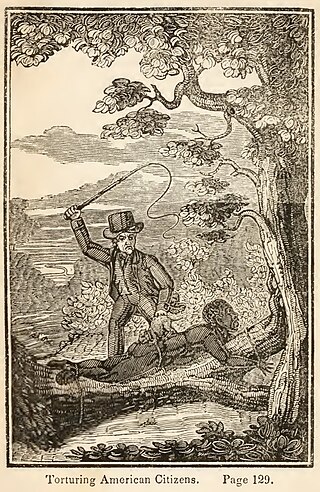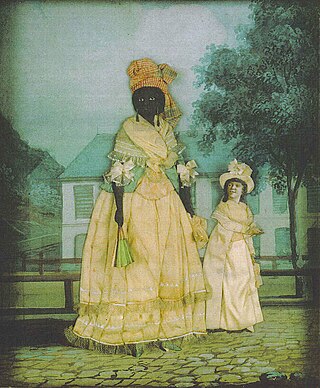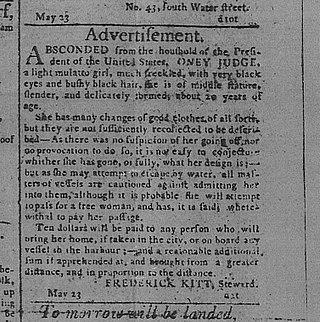Related Research Articles

Abolitionism, or the abolitionist movement, is the movement to end slavery and liberate enslaved people around the world.

Manumission, or enfranchisement, is the act of freeing slaves by their owners. Different approaches to manumission were developed, each specific to the time and place of a particular society. Historian Verene Shepherd states that the most widely used term is gratuitous manumission, "the conferment of freedom on the enslaved by enslavers before the end of the slave system".

Slavery in the colonial history of the United States refers to the institution of slavery as it existed in the European colonies which eventually became part of the United States. In these colonies, slavery developed due to a combination of factors, primarily the labour demands for establishing and maintaining European colonies, which had resulted in the Atlantic slave trade. Slavery existed in every European colony in the Americas during the early modern period, and both Africans and indigenous peoples were victims of enslavement by European colonizers during the era.

The legal institution of human chattel slavery, comprising the enslavement primarily of Africans and African Americans, was prevalent in the United States of America from its founding in 1776 until 1865, predominantly in the South. Slavery was established throughout European colonization in the Americas. From 1526, during the early colonial period, it was practiced in what became Britain's colonies, including the Thirteen Colonies that formed the United States. Under the law, an enslaved person was treated as property that could be bought, sold, or given away. Slavery lasted in about half of U.S. states until abolition in 1865, and issues concerning slavery seeped into every aspect of national politics, economics, and social custom. In the decades after the end of Reconstruction in 1877, many of slavery's economic and social functions were continued through segregation, sharecropping, and convict leasing.
The Black Codes, sometimes called the Black Laws, were laws which governed the conduct of African Americans. In 1832, James Kent wrote that "in most of the United States, there is a distinction in respect to political privileges, between free white persons and free colored persons of African blood; and in no part of the country do the latter, in point of fact, participate equally with the whites, in the exercise of civil and political rights." Although Black Codes existed before the Civil War and although many Northern states had them, the Southern U.S. states codified such laws in everyday practice. The best known of these laws were passed by Southern states in 1865 and 1866, after the Civil War, in order to restrict African Americans' freedom, and in order to compel them to work for either low or no wages.

In the British colonies in North America and in the United States before the abolition of slavery in 1865, free Negro or free Black described the legal status of African Americans who were not enslaved. The term was applied both to formerly enslaved people (freedmen) and to those who had been born free.
Antebellum South Carolina is typically defined by historians as South Carolina during the period between the War of 1812, which ended in 1815, and the American Civil War, which began in 1861.
The New-York Manumission Society was an American organization founded in 1785 by U.S. Founding Father John Jay, among others, to promote the gradual abolition of slavery and manumission of slaves of African descent within the state of New York. The organization was made up entirely of white men, most of whom were wealthy and held influential positions in society. Throughout its history, which ended in 1849 after the abolition of slavery in New York, the society battled against the slave trade, and for the eventual emancipation of all the slaves in the state. It founded the African Free School for the poor and orphaned children of slaves and free people of color.
A freedman or freedwoman is a formerly enslaved person who has been released from slavery, usually by legal means. Historically, slaves were freed by manumission, emancipation, or self-purchase. A fugitive slave is a person who escaped enslavement by fleeing.

When the Dutch and Swedes established colonies in the Delaware Valley of what is now Pennsylvania, in North America, they quickly imported enslaved Africans for labor; the Dutch also transported them south from their colony of New Netherland. Enslavement was documented in this area as early as 1639. William Penn and the colonists who settled in Pennsylvania tolerated slavery. Still, the English Quakers and later German immigrants were among the first to speak out against it. Many colonial Methodists and Baptists also opposed it on religious grounds. During the Great Awakening of the late 18th century, their preachers urged slaveholders to free people their slaves. High British tariffs in the 18th century discouraged the importation of additional slaves, and encouraged the use of white indentured servants and free labor.

Elizabeth Key Grinstead (or Greenstead) (1630 – January 20, 1665) was one of the first black people of the Thirteen Colonies to sue for freedom from slavery and win. Key won her freedom and that of her infant son John Grinstead on July 21, 1656, in the colony of Virginia.

An Act for the Gradual Abolition of Slavery, passed by the Fifth Pennsylvania General Assembly on 1 March 1780, prescribed an end for slavery in the Commonwealth of Pennsylvania in the United States. It was the first slavery abolition act in the course of human history to be adopted by a democracy.

Slavery in Maryland lasted over 200 years, from its beginnings in 1642 when the first Africans were brought as slaves to St. Mary's City, to its end after the Civil War. While Maryland developed similarly to neighboring Virginia, slavery declined here as an institution earlier, and it had the largest free black population by 1860 of any state. The early settlements and population centers of the province tended to cluster around the rivers and other waterways that empty into the Chesapeake Bay. Maryland planters cultivated tobacco as the chief commodity crop, as the market for cash crops was strong in Europe. Tobacco was labor-intensive in both cultivation and processing, and planters struggled to manage workers as tobacco prices declined in the late 17th century, even as farms became larger and more efficient. At first, indentured servants from England supplied much of the necessary labor but, as their economy improved at home, fewer made passage to the colonies. Maryland colonists turned to importing indentured and enslaved Africans to satisfy the labor demand.
William Ellison Jr.(April 1790 – December 5, 1861), born April Ellison, was a USA cotton gin maker and blacksmith in South Carolina, and former African-American slave who achieved considerable success as a slaveowner before the American Civil War. He eventually became a major planter and one of the wealthiest property owners in the state. According to the 1860 census, he owned up to 68 black slaves, making him the largest of the 171 black slaveholders in South Carolina. He held 63 slaves at his death and more than 900 acres (360 ha) of land. From 1830 to 1865 he and his sons were the only free blacks in Sumter County, South Carolina to own slaves. The county was largely devoted to cotton plantations, and the majority population were slaves.

Freedom suits were lawsuits in the Thirteen Colonies and the United States filed by slaves against slaveholders to assert claims to freedom, often based on descent from a free maternal ancestor, or time held as a resident in a free state or territory.

Anti-literacy laws in many slave states before and during the American Civil War affected slaves, freedmen, and in some cases all people of color. Some laws arose from concerns that literate slaves could forge the documents required to escape to a free state. According to William M. Banks, "Many slaves who learned to write did indeed achieve freedom by this method. The wanted posters for runaways often mentioned whether the escapee could write." Anti-literacy laws also arose from fears of slave insurrection, particularly around the time of abolitionist David Walker's 1829 publication of Appeal to the Colored Citizens of the World, which openly advocated rebellion, and Nat Turner's slave rebellion of 1831.

In the United States, abolitionism, the movement that sought to end slavery in the country, was active from the late colonial era until the American Civil War, the end of which brought about the abolition of American slavery through the Thirteenth Amendment to the United States Constitution.

Slavery in Florida is more central to Florida's history than it is to almost any other state. Florida's purchase by the United States from Spain in 1819 was primarily a measure to strengthen the system of slavery on Southern plantations, by denying potential runaways the formerly safe haven of Florida.
The Guardian of Sally v. Beatty was a 1792 court case decided in the Supreme Court of South Carolina. A jury charged by Chief Justice John Rutledge held that a slave who had been bought and manumitted by another slave was free, not the other slave's owner's property.

Slavery was legally practiced in the Province of North Carolina and the state of North Carolina until January 1, 1863, when President Abraham Lincoln issued the Emancipation Proclamation. Prior to statehood, there were 41,000 enslaved African-Americans in the Province of North Carolina in 1767. By 1860, the number of slaves in the state of North Carolina was 331,059, about one third of the total population of the state. In 1860, there were nineteen counties in North Carolina where the number of slaves was larger than the free white population. During the antebellum period the state of North Carolina passed several laws to protect the rights of slave owners while disenfranchising the rights of slaves. There was a constant fear amongst white slave owners in North Carolina of slave revolts from the time of the American Revolution. Despite their circumstances, some North Carolina slaves and freed slaves distinguished themselves as artisans, soldiers during the Revolution, religious leaders, and writers.
References
- Bassett, John S. Slavery in the State of North Carolina. Johns Hopkins Press, Baltimore. (1899) http://docsouth.unc.edu/nc/bassett99/bassett99.html
- Berlin, Ira. Slaves Without Masters: The Free Negro in the Antebellum South. Oxford University Press, London and New York. (1974)
- Cover, Robert. Justice Accused: Antislavery and the Judicial Process. Yale University Press, New Haven and New York. (1975)
- Franklin, John H. The Free Negro in North Carolina. University of North Carolina Press, Chapel Hill and London. (1971)
- Morris, Thomas. Southern Slavery and the Law, 1619-1860. University of North Carolina Press, Chapel Hill and London. (1996)
- Weeks, Stephen Beauregard. Southern Quakers and Slavery: A Study in Institutional History. Johns Hopkins Press, Baltimore. (1896). https://books.google.com/books/about/Southern_Quakers_and_slavery.html?id=DguMLrwnlmoC